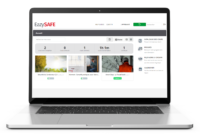Working at Height in Ireland
Safety & Compliance Guide
Falls from height remain one of the leading causes of workplace fatalities and serious injuries in Ireland, accounting for 28% of deaths in the construction sector alone (HSA, 2023). These incidents are often sudden, severe, and entirely preventable. Whether you’re working in construction, maintenance, warehousing, or any other environment where working at height is required, the risks are real and ever-present.
Compliance with Irish health and safety legislation is not merely a box to tick—it is both a legal requirement and a moral obligation. Employers and workers alike have a shared responsibility to prioritise safety through proper training, use of protective equipment, and adherence to safe work practices. Proactive measures can prevent tragic outcomes and help ensure that everyone returns home safely at the end of the day.
This guide covers:
- Irish working-at-height regulations (SHWW Act, Work at Height Regulations)
- Key hazards & accident prevention
- Hierarchy of controls (elimination to PPE)
- Mandatory training & equipment standards
- Emergency planning & permits

What Legally Counts as “Working at Height” in Ireland?
Under the Safety, Health and Welfare at Work (General Application) Regulations 2007, working at height applies to any task where a fall could cause injury, including:
- Roof work (even at low levels)
- Ladders, scaffolding, or mobile platforms
- Near fragile surfaces (e.g., skylights, asbestos roofs)
- Edge work (unprotected balconies, loading bays)
Key Irish Thresholds:
- No minimum height—if a fall could cause injury, it’s regulated.
- Fragile surfaces require extra precautions (e.g., crawling boards).

Irish Legal Requirements for Employers:
The Work at Height Regulations (2006) and SHWW Act 2005 mandate:
- Avoid working at height where possible (e.g., prefabricate on ground level).
- Conduct a risk assessment (documented for HSA inspections).
- Use collective protection (guardrails, scaffolding) before PPE.
- Provide certified training (e.g., harness use, ladder safety).
Penalties for Non-Compliance:
- Fines up to €3 million or 2 years imprisonment (HSA enforcement).

Most Common Hazards in Irish Workplaces:
Irish HSA data shows falls often occur due to:
- Unsecured ladders (40% of incidents)
- Collapsing scaffolding (poor assembly/maintenance)
- Fragile roofs (agricultural & industrial buildings)
- No edge protection (construction sites, warehouses)

Hierarchy of Control Measures:
Follow this legally required order of risk reduction:
- Eliminate (Can the work be done from the ground?)
- Prevent falls (e.g., guardrails, fixed platforms)
- Minimize fall distance (safety nets, airbags)
- PPE (harnesses as a last resort—must be inspected every 6 months).
Irish Standards for Equipment:
- Scaffolding: Compliant with IS EN 12811
- Harnesses: IS EN 361 + lanyards (IS EN 355)

Mandatory Training & Certification in Ireland:
Under Regulation 5 of the Work at Height Regulations, workers must receive:
- Working at Height Training (e.g., EazySafe’s certified courses)
- Equipment-specific training (scaffold erection, MEWP operation)
- Refresher courses every 3 years (or after incidents)
Who Needs Training?
- Construction crews
- Window cleaners
- Warehouse staff (using mezzanines)

Emergency Planning for Falls:
Irish law requires:
- Rescue plans (no “suspension trauma” from hanging harnesses)
- First-aid trained staff onsite
- Documented drills (tested annually)
Key Takeaways
Prioritize prevention over PPE: The hierarchy of control measures legally requires employers to first eliminate the hazard if possible, then use collective protection (like guardrails), and only use personal protective equipment (PPE) such as harnesses as a last resort.
Train staff—untrained workers are 3x more likely to fall (HSA): Workers must receive certified training for working at height, including equipment-specific training (like scaffold erection or MEWP operation), with refresher courses required every 3 years or after incidents. Untrained workers are significantly more likely to be involved in fall incidents, according to the HSA.
Inspect equipment (ladders, scaffolds) before each use: It is essential to inspect all equipment, including ladders and scaffolds, before each use to ensure it is in safe working condition.
Document everything—HSA inspectors can request records: Employers must maintain thorough documentation related to working at height activities, as Health and Safety Authority (HSA) inspectors have the authority to request these records.

Discover our Safety Training Platform
Train your employees anytime, anywhere with our environmental, health, safety and wellness training platform.

TAILORED TRAINING
Discover our safety training courses and ehs onboardings, which can be customised and offered in several languages.

SAFETY MANAGEMENT
Ensure the distribution of your safety policy by training your permanent, temporary or seasonal staff.

GLOBAL MONITORING
Simplify the management of your safety policy thanks to the numerous dashboards and training reports.
Related Posts
